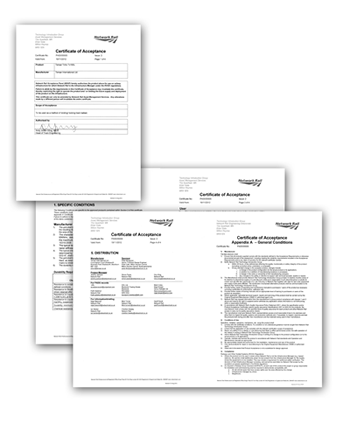 |
Tensar TriAx® TX190L geogrid has been developed specifically to improve rail track ballast stability and so maintain track geometry. Its unique advantages are recognised in the November 2012 issue of Certificate No. PA05/05505 by Network Rail’s Technology Introduction Group, Asset Management Services; Network Rail endorsement is widely regarded internationally as representing the highest technical standards.
Tensar TX190L (PADS no. 057/100470) can be used for both sub-ballast and ballast stabilisation in new track bed and renewals and maintenance upgrades. Its benefits for rail networks include extended maintenance cycles and reduced whole life costs, as well as reduced construction time and traffic disruption with their associated additional costs.
TX190L is a new large aperture version of Tensar’s revolutionary and highly successful TriAx® geogrid, with large apertures designed to match track ballast particle size. It is also suitable for recycled aggregates and thus offers further potential cost savings in sub-ballast applications.
“We have established the value of Tensar geogrid ballast stabilisation solutions all over the world,” comments Cliff Hall, Group Stabilisation Manager for Tensar.”
Peter Musgrave, Senior Track Bed Design Engineer for Network Rail, points out that, currently, more than 10% of all (UK) ballast maintenance per year now includes geogrid stabilisation.
“International rail networks acknowledge that the Network Rail Certificate of Acceptance enables the industry to take advantage of the stabilisation advances we have made with TX190L, compared with earlier rectangular geogrids. As a result, not only could accumulated track bed maintenance costs be halved but also the payback period is less than three ballast tamping cycles.”
The multi award winning TriAx® concept has brought improved mechanical stability and load bearing performance to a number infrastructure and construction industry applications, since its launch in 2007.
Researchers in the UK and around the world have found that geogrid stabilisation of ballast has led to better preservation of rail line and level; this improvement in track geometry is found to be three to five times better than a sleeper settlement without geogrid stabilisation, and therefore allows the time between maintenance cycles to be increased.
Track bed stabilisation is part of a range of benefits offered by Tensar geogrid technology, including soil stabilisation for slopes and embankments, retaining walls and bridge abutments, differential settlement protection through mechanical stabilisation over soft subgrades and temporary access roads for construction plant access.
For more information on Tensar TriAx® TX190L and Tensar technology rail solutions, please visit http://www.tensar.co.uk/Market-Sector/Rail











